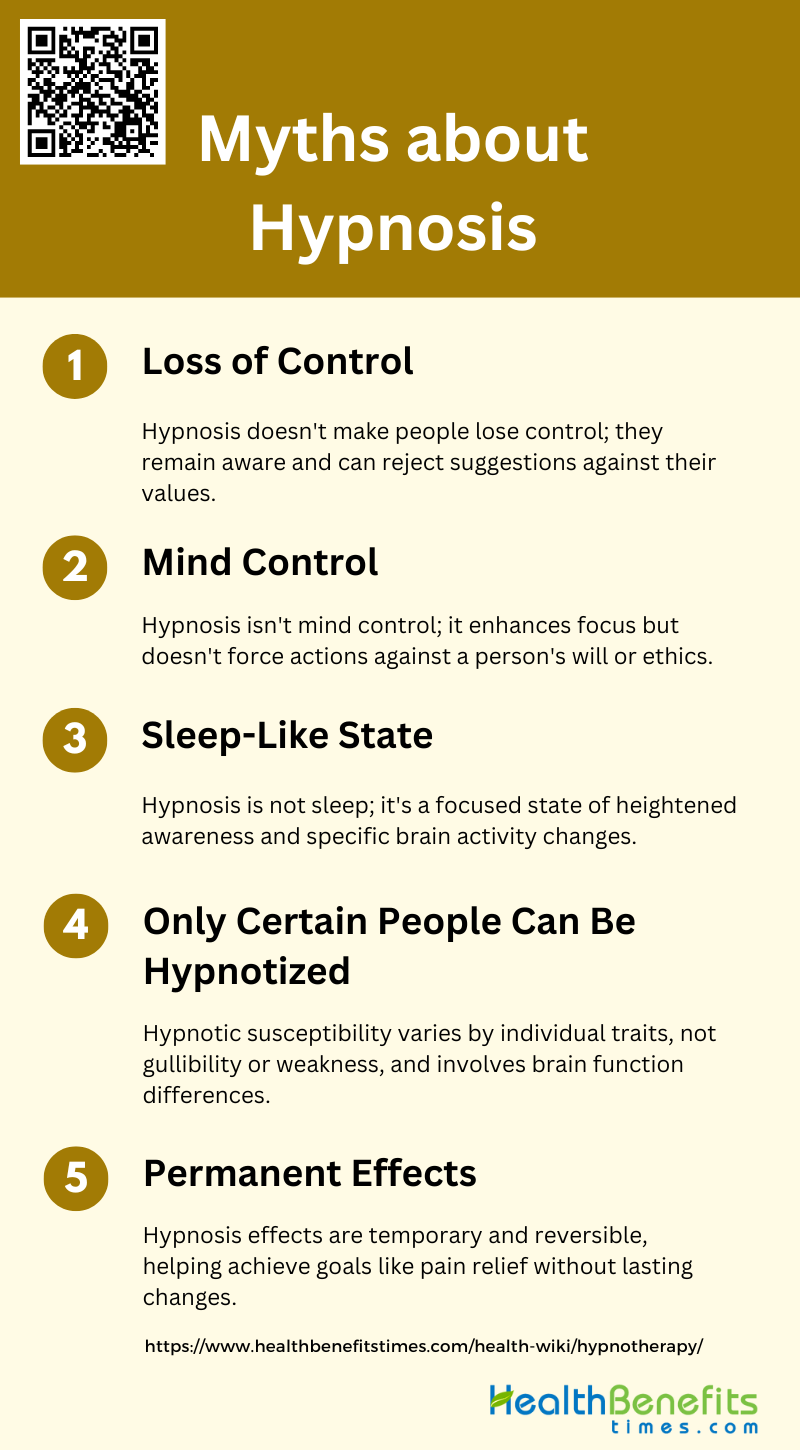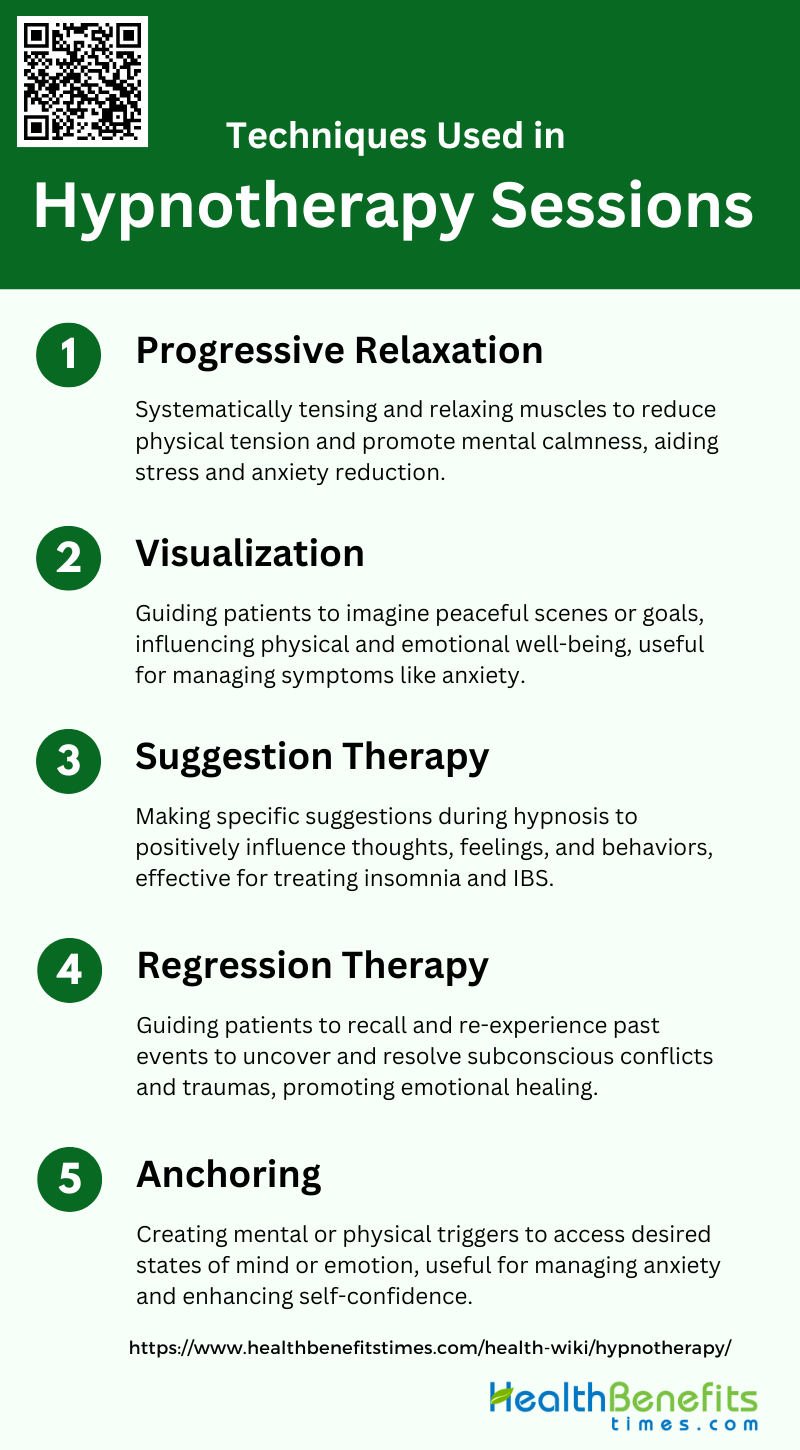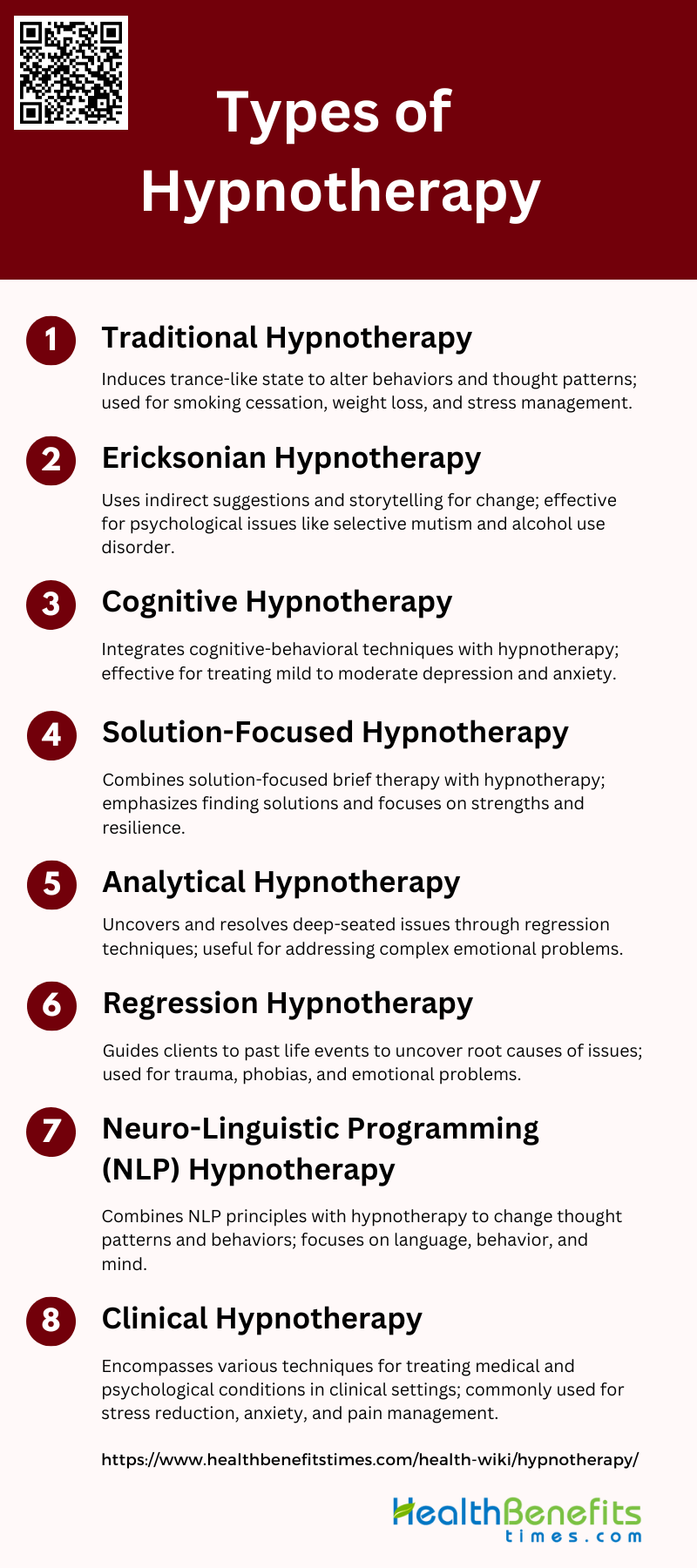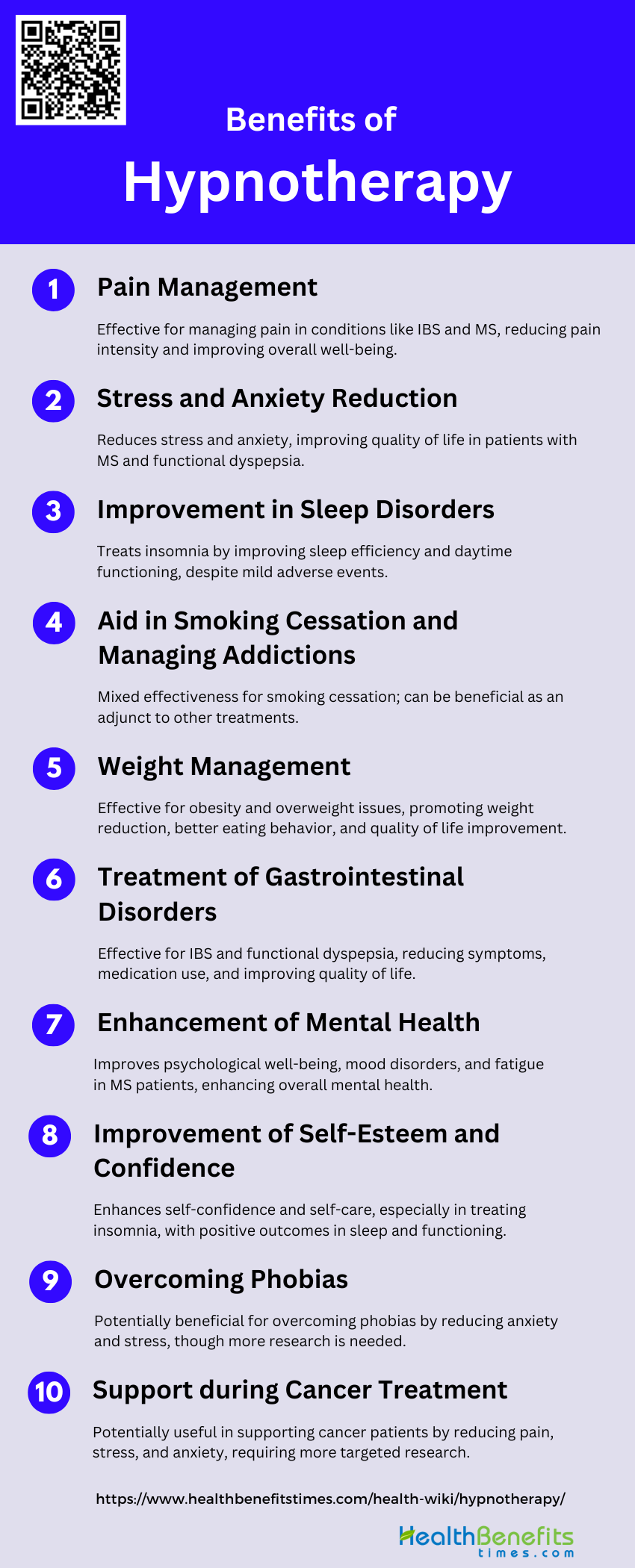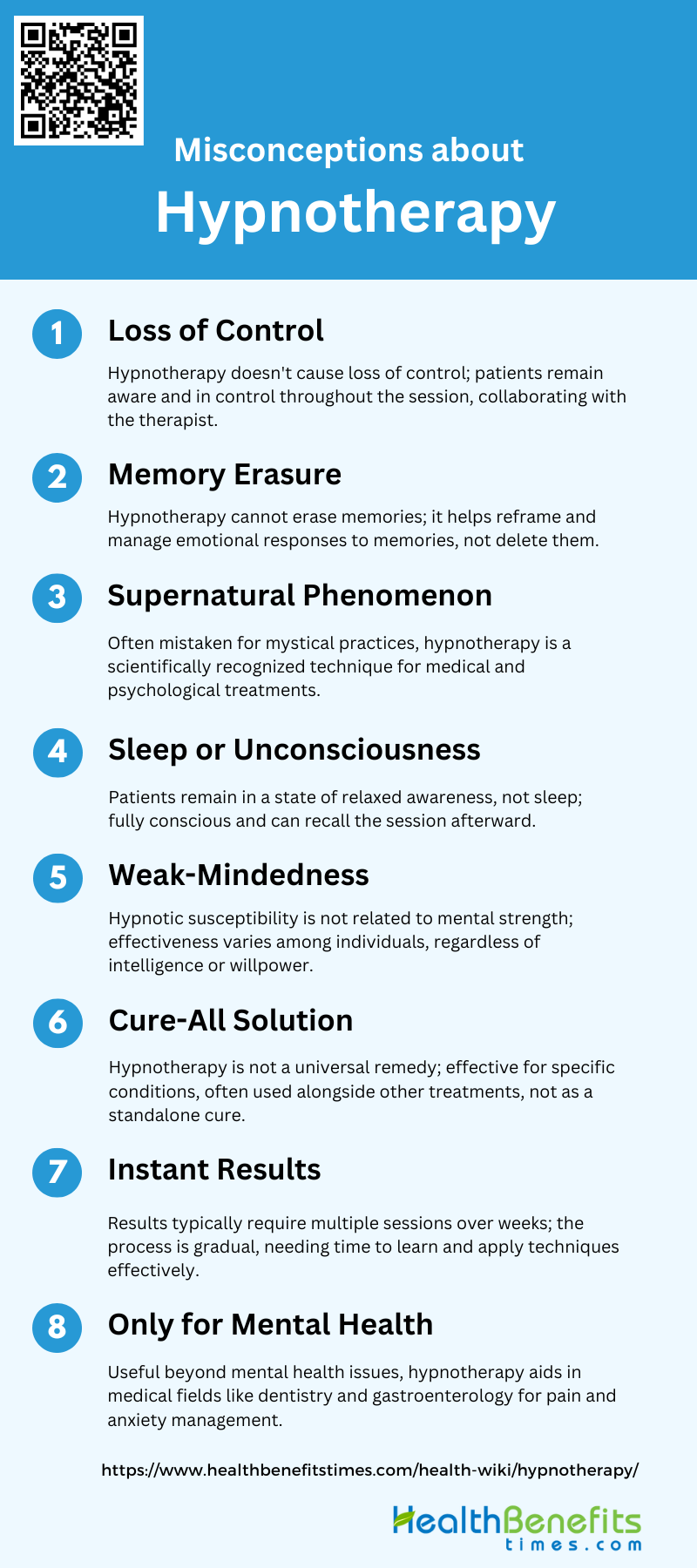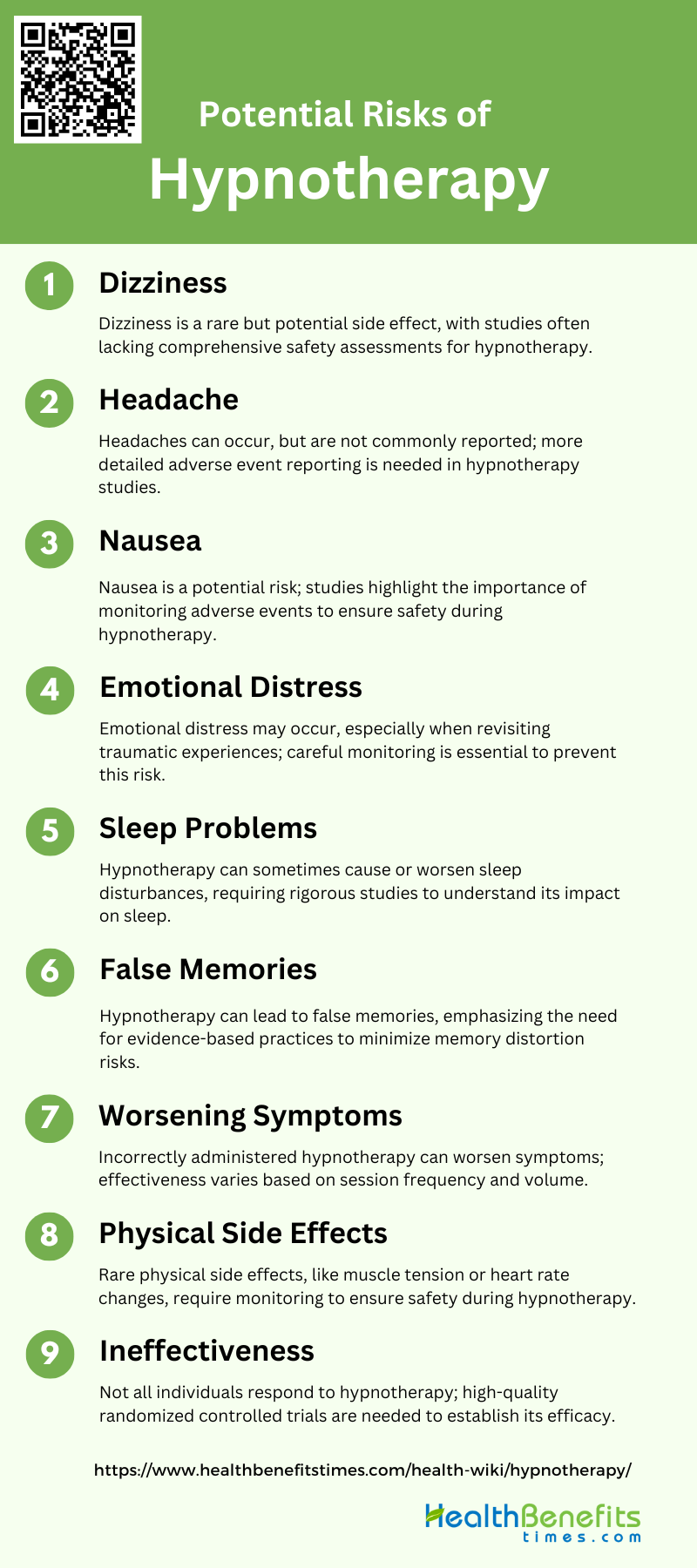Hypnotherapy is a therapeutic technique that utilizes hypnosis to treat various medical and psychological conditions. It involves inducing a state of focused attention and heightened suggestibility, during which the patient is more open to suggestions and guidance from the therapist. This state can help address issues such as anxiety, pain, phobias, and gastrointestinal disorders by altering perceptions, behaviors, and emotional responses. Hypnotherapy has been shown to be effective in managing conditions like irritable bowel syndrome (IBS), complex regional pain syndrome (CRPS), and dental anxiety in children, among others, by reducing symptoms and improving quality of life.
How does hypnotherapy works?
It has been shown to be effective in various conditions, including smoking cessation, depression, irritable bowel syndrome (IBS), and functional dyspepsia. For smoking cessation, hypnotherapy targets underlying impulses to weaken the desire to smoke or strengthen the will to quit, although evidence on its efficacy compared to other treatments is mixed. In the treatment of depression, hypnotherapy has been found to be non-inferior to cognitive behavioral therapy (CBT), suggesting it can be a viable alternative. For gastrointestinal disorders like IBS and functional dyspepsia, hypnotherapy has demonstrated significant long-term improvements in symptoms and quality of life, often outperforming other supportive therapies. Additionally, hypnotherapy has been effectively used in pediatric gastroenterology to manage pain, stress, and anxiety, further highlighting its versatility and potential benefits across different age groups and conditions.
Myths about hypnosis
Here are some common myths about hypnosis:
1. Loss of Control
A common myth about hypnosis is that individuals lose control over their actions and can be made to do things against their will. However, research indicates that this is not the case. During hypnosis, individuals remain aware of their surroundings and retain the ability to make decisions and reject suggestions that go against their values or desires. Hypnosis involves a heightened state of focus and concentration, but it does not override personal control or moral judgment. This misconception has likely discouraged many from exploring the therapeutic benefits of hypnosis, such as pain management and symptom alleviation in conditions like irritable bowel syndrome (IBS).
2. Mind Control
Another prevalent myth is that hypnosis can be used as a form of mind control, where the hypnotist can manipulate the subject’s thoughts and actions without their consent. Scientific studies have debunked this myth, showing that hypnosis cannot force individuals to act against their will or ethical beliefs. The hypnotic state is characterized by increased suggestibility, but this does not equate to mind control. Instead, it allows individuals to focus more deeply on specific thoughts or tasks, which can be beneficial in therapeutic settings. The notion of mind control is more a product of fiction and media portrayal than scientific reality.
3. Sleep-Like State
Many people believe that hypnosis induces a sleep-like state, where the individual is unconscious or unaware of their surroundings. In reality, hypnosis is a state of focused attention and heightened awareness, not sleep. Brain imaging studies have shown that hypnotic states involve specific changes in brain activity, particularly in areas related to consciousness and attention, such as the anterior cingulate cortex and thalamus. These findings support the idea that hypnosis is an altered state of consciousness rather than a form of sleep. The misconception of hypnosis as sleep may stem from the term “neuro-hypnotism,” which means “nervous sleep” but does not accurately describe the hypnotic experience.
4. Only Certain People Can Be Hypnotized
There is a myth that only certain individuals, often those who are gullible or weak-minded, can be hypnotized. However, research shows that hypnotic susceptibility varies among individuals and is not related to gullibility or weakness. Factors such as intrinsic motivation, personality traits, and the ability to focus play a significant role in how susceptible a person is to hypnosis. Studies using transcranial magnetic stimulation have demonstrated that individuals classified as highly hypnotizable show greater corticospinal activation during hypnosis, indicating that susceptibility is more about individual differences in brain function than any inherent weakness.
5. Permanent Effects
Some people fear that hypnosis can have permanent effects on their mind or behavior. This myth is unfounded, as the effects of hypnosis are typically temporary and reversible. Hypnosis is a tool that can help individuals achieve specific goals, such as pain relief or stress reduction, but it does not cause lasting changes unless reinforced through repeated sessions or additional therapeutic interventions. The idea of permanent effects likely arises from misunderstandings about the nature of hypnosis and its portrayal in popular culture. In reality, hypnosis is a safe and controlled process when conducted by trained professionals.
Techniques used in Hypnotherapy sessions
These methods are designed to facilitate relaxation, enhance concentration, and promote positive behavioral changes. Here are some common techniques used in hypnotherapy sessions:
1. Progressive Relaxation
Progressive relaxation is a technique often used in hypnotherapy to help individuals achieve a state of deep relaxation. This method involves systematically tensing and then relaxing different muscle groups in the body. The goal is to reduce physical tension and promote mental calmness. Studies have shown that progressive relaxation can be effective in reducing stress and anxiety, which are common triggers for various conditions such as headaches and insomnia. For instance, a study comparing hypnotherapy and progressive muscle relaxation in children with primary headaches found both techniques to be equally effective in reducing headache frequency and severity.
2. Visualization
Visualization in hypnotherapy involves guiding the patient to imagine a peaceful and calming scene or to visualize achieving a specific goal. This technique leverages the power of the mind to influence physical and emotional well-being. Visualization has been used effectively in various therapeutic settings, including the management of chronic dyspnea in pediatric patients, where it helped alleviate symptoms by promoting relaxation and reducing anxiety. Additionally, visualization techniques have been employed in the treatment of cancer patients to help manage symptoms such as pain, nausea, and anxiety.
3. Suggestion Therapy
Suggestion therapy is a core component of hypnotherapy, where the therapist makes specific suggestions to the patient while they are in a hypnotic state. These suggestions are designed to influence the patient’s thoughts, feelings, and behaviors positively. Research has shown that suggestion therapy can be effective in treating conditions like insomnia, where both disease-specific and generic hypnotic suggestions have been found to improve sleep efficiency and reduce insomnia severity. Suggestion therapy has also been used to manage symptoms in patients with irritable bowel syndrome (IBS), showing significant improvements in symptom relief.
4. Regression Therapy
Regression therapy involves guiding the patient to recall and re-experience past events, often from childhood, that may be contributing to their current issues. This technique aims to uncover and resolve subconscious conflicts and traumas. In the context of hypnotherapy, regression has been used to help patients with psychotic and borderline conditions by reducing anxiety and building ego strength through the re-experiencing of past events in a controlled and therapeutic environment. Additionally, age regression and recovery of early recollections are techniques used in group hypnotherapy to foster insight and emotional healing.
5. Anchoring
Anchoring is a technique used in hypnotherapy to create a mental or physical trigger that can help the patient access a desired state of mind or emotion. This is often achieved by associating a specific gesture, word, or image with a positive feeling or state of relaxation. Anchoring can be particularly useful in managing anxiety and enhancing self-confidence. For example, in the treatment of insomnia, hypnotherapists may use anchoring to help patients quickly achieve a state of relaxation and readiness for sleep. This technique has also been employed in the management of chronic dyspnea, where patients use self-hypnosis and anchoring to alleviate symptoms and improve their quality of life.
Types of Hypnotherapy
Each type of hypnotherapy utilizes different methods and approaches to address specific issues or goals. Below is a list of some common types of hypnotherapy:
1. Traditional Hypnotherapy
Traditional hypnotherapy involves inducing a trance-like state to access the subconscious mind, aiming to change behaviors and thought patterns. It is often used for smoking cessation, weight loss, and stress management. Studies have shown that traditional hypnotherapy can be effective for conditions like irritable bowel syndrome (IBS) and smoking cessation, although the evidence is mixed and often limited by methodological issues.
2. Ericksonian Hypnotherapy
Ericksonian hypnotherapy, developed by Milton H. Erickson, uses indirect suggestions and storytelling to facilitate change. It is characterized by its permissive and flexible approach, making it adaptable to various therapeutic contexts. This method has been widely adopted and is considered effective for a range of psychological issues, including selective mutism and alcohol use disorder. It is also noted for its influence on other therapeutic approaches like Solution-Focused Brief Therapy (SFBT).
3. Cognitive Hypnotherapy
Cognitive hypnotherapy integrates cognitive-behavioral techniques with hypnotherapy to address issues like depression and anxiety. Research indicates that cognitive hypnotherapy can be as effective as cognitive-behavioral therapy (CBT) for treating mild to moderate depression, offering a viable alternative for patients.
4. Solution-Focused Hypnotherapy
Solution-focused hypnotherapy combines elements of solution-focused brief therapy with hypnotherapy. It emphasizes finding solutions rather than focusing on problems. This approach shares similarities with Ericksonian hypnotherapy, particularly in its use of language and focus on strengths and resilience.
5. Analytical Hypnotherapy
Analytical hypnotherapy aims to uncover and resolve deep-seated issues and traumas by exploring the subconscious mind. It often involves regression techniques to revisit past experiences. This method is particularly useful for addressing complex emotional problems and is considered a more intensive form of hypnotherapy.
6. Regression Hypnotherapy
Regression hypnotherapy involves guiding clients back to earlier life events to uncover the root causes of current issues. This technique is often used to address trauma, phobias, and other deep-seated emotional problems. It requires skilled practitioners to navigate the potentially sensitive nature of the memories and emotions that may surface.
7. Neuro-Linguistic Programming (NLP) Hypnotherapy
NLP hypnotherapy combines the principles of neuro-linguistic programming with hypnotherapy to change thought patterns and behaviors. It focuses on the relationship between language, behavior, and the mind. This approach is often used for personal development, performance enhancement, and overcoming limiting beliefs.
8. Clinical Hypnotherapy
Clinical hypnotherapy is a broad term that encompasses various hypnotherapy techniques used in a clinical setting to treat medical and psychological conditions. It is commonly used for stress reduction, anxiety, pain management, and other health-related issues. Surveys indicate that Ericksonian, hypnotic relaxation therapy, and traditional hypnosis are the most commonly used approaches in clinical settings.
Benefits of Hypnotherapy
By tapping into the subconscious mind, it helps individuals overcome various challenges and achieve personal growth. Below is a list of some key benefits of hypnotherapy:
1. Pain Management
Patients reported significant reductions in pain intensity and improvements in overall well-being. Additionally, hypnotherapy has been beneficial in reducing chronic pain and improving physical functioning in multiple sclerosis (MS) patients.
2. Stress and Anxiety Reduction
It helps improve quality of life by alleviating stress, depression, and anxiety symptoms. Hypnotherapy also showed improvements in anxiety and depression scores in patients with functional dyspepsia.
3. Improvement in Sleep Disorders
Both disease-specific and generic hypnotic suggestions produced similar positive outcomes, although adverse events were common but mostly mild.
4. Aid in Smoking Cessation and Managing Addictions
The effectiveness of hypnotherapy for smoking cessation is mixed. Some studies suggest it is more effective than nicotine replacement therapy (NRT) and can be beneficial as an adjunct to other treatments. However, other studies indicate that hypnotherapy does not show a significant advantage over other behavioral interventions or no treatment.
5. Weight Management
It promotes weight reduction during and after treatment, improves eating behavior, and enhances quality of life. However, more well-designed studies are needed to confirm these findings.
6. Treatment of Gastrointestinal Disorders
It reduces global gastrointestinal symptoms, improves quality of life, and decreases medication use and consultation rates. In pediatric gastroenterology, it also helps reduce pain, stress, and anxiety.
7. Enhancement of Mental Health
Hypnotherapy has shown beneficial impacts on psychological well-being, mood disorders, and fatigue in MS patients. It significantly improves mental health and quality of life, making it a suitable nonpharmacological treatment for psychological symptoms.
8. Improvement of Self-Esteem and Confidence
Generic hypnotic suggestions aimed at boosting self-confidence showed positive outcomes in sleep and daytime functioning.
9. Overcoming Phobias
While specific studies on hypnotherapy for phobias were not provided, the general effectiveness of hypnotherapy in reducing anxiety and stress suggests potential benefits in overcoming phobias. Further research is needed to substantiate this application.
10. Support during Cancer Treatment
Although specific studies on hypnotherapy for cancer treatment support were not provided, the general benefits of hypnotherapy in reducing pain, stress, and anxiety indicate its potential usefulness in supporting cancer patients. More targeted research is required to confirm these benefits.
Misconceptions about Hypnotherapy
These misunderstandings can prevent people from considering hypnotherapy as a viable treatment option. Below is a list of some common misconceptions about hypnotherapy:
1. Loss of Control
A common misconception about hypnotherapy is that it causes a loss of control, making individuals act against their will. However, hypnotherapy is a state of focused attention and heightened suggestibility, not mind control. Patients remain aware and in control of their actions throughout the session. Studies have shown that hypnotherapy is a collaborative process where the therapist guides the patient to achieve therapeutic goals, such as managing symptoms of IBS or insomnia, without compromising their autonomy.
2. Memory Erasure
Another myth is that hypnotherapy can erase memories. In reality, hypnotherapy does not have the capability to delete or alter memories. It can, however, help individuals reframe and manage their emotional responses to certain memories. This therapeutic approach is used to address various psychological issues by altering the perception of past events rather than erasing them.
3. Supernatural Phenomenon
This misconception likely stems from its portrayal in popular media as a form of magical mind control. In truth, hypnotherapy is a scientifically recognized therapeutic technique used in medical and psychological treatments. It involves inducing a state of focused attention and heightened suggestibility to facilitate positive changes in behavior and perception.
4. Sleep or Unconsciousness
Many people believe that hypnotherapy involves putting the patient to sleep or rendering them unconscious. However, during hypnotherapy, patients are in a state of relaxed awareness, not sleep. They are fully conscious and can recall the session afterward. This state allows them to focus intensely on specific thoughts or tasks, which can be particularly beneficial in treating conditions like insomnia or IBS.
5. Weak-Mindedness
There is a misconception that only weak-minded individuals can be hypnotized. In reality, the ability to be hypnotized is not related to mental strength or weakness. Hypnotic susceptibility varies among individuals, but it is not an indicator of intelligence or willpower. Hypnotherapy can be effective for a wide range of people, regardless of their mental fortitude, and is used to treat various conditions, including smoking cessation and dental anxiety.
6. Cure-All Solution
Some believe that hypnotherapy is a cure-all solution for any ailment. While hypnotherapy can be highly effective for certain conditions, such as IBS, insomnia, and smoking cessation, it is not a universal remedy. Its effectiveness depends on the condition being treated and the individual’s responsiveness to hypnosis. It is often used as a complementary therapy alongside other treatments rather than a standalone cure.
7. Instant Results
Another myth is that hypnotherapy provides instant results. In reality, hypnotherapy typically requires multiple sessions over several weeks to achieve significant and lasting outcomes. For example, gut-directed hypnotherapy for IBS involves weekly sessions over 6-12 weeks. The process is gradual, and patients often need time to learn and apply the techniques effectively.
8. Only for Mental Health
Many people think hypnotherapy is only useful for mental health issues. While it is indeed effective for psychological conditions, hypnotherapy is also used in medical fields, such as dentistry and gastroenterology. It can help manage pain, reduce anxiety, and improve symptoms of various physical conditions. For instance, gut-directed hypnotherapy has shown benefits in treating IBS by normalizing gastrointestinal function.
Potential Risks of Hypnotherapy
While hypnotherapy can offer numerous benefits, it is important to be aware of the potential risks involved. These risks can vary depending on the individual’s condition and the practitioner’s expertise. Below is a list of some potential risks of hypnotherapy:
1. Dizziness
Dizziness is a potential side effect of hypnotherapy, although it is not frequently reported. In studies examining the safety of hypnotherapy for various conditions, adverse events such as dizziness are seldom investigated or documented. For instance, a systematic review on hypnotherapy for insomnia did not report any adverse events, including dizziness, but acknowledged the need for more comprehensive safety assessments in future studies. Similarly, another study on hypnotherapy for smoking cessation found no significant differences in adverse events, including dizziness, between hypnotherapy and other interventions.
2. Headache
Headaches can occur as a side effect of hypnotherapy, though they are not commonly reported. A systematic review of hypnotherapy for the management of headaches, including migraines, found that hypnotherapy and relaxation techniques were effective in reducing headache activity. However, the review did not specifically address the incidence of headaches as a side effect of the treatment itself. The lack of detailed adverse event reporting in many hypnotherapy studies suggests that more rigorous monitoring is needed to fully understand the prevalence of headaches as a side effect.
3. Nausea
Nausea is another potential risk associated with hypnotherapy. A study protocol for gut-directed hypnotherapy in children with functional nausea or functional dyspepsia aims to evaluate the efficacy of hypnotherapy in reducing nausea. While the primary focus is on the therapeutic benefits, the study also acknowledges the importance of monitoring adverse events, including nausea, to ensure the safety of the intervention. Additionally, a review on hypnotherapy in cancer care noted that hypnotherapy could help manage nausea and vomiting, but did not extensively discuss nausea as a side effect.
4. Emotional Distress
Emotional distress can be a significant risk during hypnotherapy, especially if the therapy involves revisiting traumatic experiences. A review on hypnotherapy in cancer care highlighted the potential benefits of hypnotherapy in reducing psychological disturbances such as anxiety and depression. However, it also emphasized the need for careful monitoring to prevent emotional distress during sessions. Similarly, a study on hypnotherapy for procedural pain and distress in children noted the importance of addressing emotional distress as part of the intervention.
5. Sleep Problems
While hypnotherapy is often used to treat sleep problems, it can paradoxically cause or exacerbate sleep disturbances in some cases. A systematic review of hypnotherapy for sleep disturbances found mixed results, with some studies reporting improvements in sleep quality and others showing no significant impact. The review also highlighted the need for more rigorous studies to better understand the potential for hypnotherapy to cause sleep problems as a side effect. Another study on hypnotherapy for insomnia reported improvements in sleep efficiency but called for better monitoring of adverse events, including sleep disturbances.
6. False Memories
The risk of false memories is a well-documented concern in hypnotherapy. Hypnotherapy can sometimes lead to the creation of false memories, particularly when used to recover repressed memories. This phenomenon is known as “memory distortion” and can have serious implications for the individual’s mental health and well-being. A review on hypnotherapy for various conditions emphasized the importance of using evidence-based practices to minimize the risk of false memories and other cognitive distortions. The potential for false memories underscores the need for careful and ethical practice in hypnotherapy.
7. Worsening Symptoms
In some cases, hypnotherapy can lead to a worsening of symptoms, particularly if not administered correctly. A systematic review of hypnotherapy for irritable bowel syndrome (IBS) found that while hypnotherapy generally reduced gastrointestinal symptoms, the effectiveness varied based on the frequency and volume of sessions. The review suggested that inadequate or improperly administered hypnotherapy could potentially worsen symptoms. Another study on hypnotherapy for insomnia reported that adverse events, including worsening symptoms, were common but mostly mild.
8. Physical Side Effects
Physical side effects, though rare, can occur during hypnotherapy sessions. These may include muscle tension, changes in heart rate, or other physiological responses. A review on hypnotherapy for procedural pain and distress in children noted the importance of monitoring physical side effects to ensure the safety and efficacy of the intervention. Similarly, a study on hypnotherapy for smoking cessation highlighted the need for comprehensive assessments of safety, including the monitoring of physical side effects.
9. Ineffectiveness
Ineffectiveness is a potential risk of hypnotherapy, as not all individuals respond to the treatment. A systematic review of hypnotherapy for smoking cessation found insufficient evidence to determine whether hypnotherapy was more effective than other forms of behavioral support or unassisted quitting. The review emphasized the need for more high-quality randomized controlled trials to establish the efficacy of hypnotherapy. Similarly, a review on hypnotherapy for sleep disturbances found mixed results, with some studies showing positive outcomes and others showing no significant impact.



